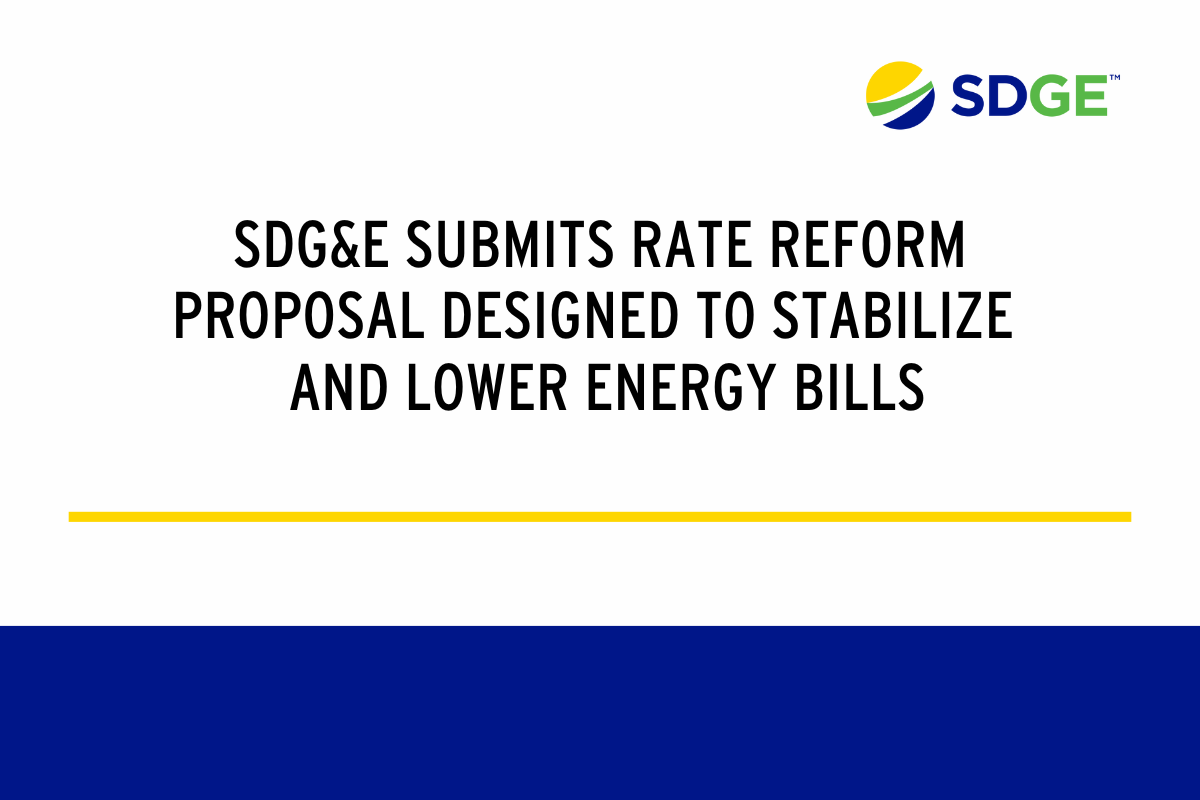Reform plan central component of SDG&E affordability strategy and focuses on savings for middle- and lower-income customers
SAN DIEGO, April 10, 2023 – Seeking to provide financial relief for low-to-moderate income customers while supporting California’s climate goals, San Diego Gas & Electric has submitted a proposal, along with other California utilities, to reform how consumers are charged for electricity.
“We have listened to and heard from our customers that fundamental change is needed to provide bill relief,” SDG&E CEO Caroline Winn said. “When we were putting together the reform proposal, front and center in our mind were customers who live paycheck to paycheck, who struggle to pay for essentials such as, energy, housing and food.”
The electric pricing reform proposal is a central element of SDG&E’s four-part plan to improve affordability for customers, which also includes:
- Pursuing federal funds available through the Infrastructure Investment and Jobs Act to pay for critical electric infrastructure, and maximizing federal tax credits for battery storage and microgrid facilities that can be refunded to customers;
- Advocating for legislation (AB 982) to remove costs from electric rates that could reduce monthly bills up to 7% and legislation (AB 1513) to spread the cost of wildfire safety improvements over a longer period of time to reduce rate impacts;
- Stabilizing natural gas bills by advocating for improved utilization of existing infrastructure
SDG&E submitted the electric rate proposal in response to a new state law (AB 205) passed in 2022 requiring the California Public Utilities Commission (CPUC) to adopt a fixed price – based on household income - to help fund electric delivery infrastructure such as poles, wires, meters and customer service.
Under the SDG&E plan, customers would pay a fixed price that covers most of the utility’s energy delivery service that would not change month-to-month regardless of how much electricity is consumed.
This approach dramatically reduces the average electric rate – the per kilowatt hour cost – that customers pay by 42% compared to today. This portion of a customer’s bill, which is mostly related to the electricity purchased from natural gas, wind and solar plants, will continue to vary based on electricity usage. In San Diego County, nearly 85% of customers have their electricity purchased by local governments known as community choice aggregators or other entities – not SDG&E.
A fixed pricing component to help pay for infrastructure is used throughout the U.S., including local municipal water and sewer agencies. California is one of the few states that does not include a required fixed pricing component in electric rates offered by its regulated utilities.
The proposed reform will provide immediate financial relief to low-to-moderate income families, with estimated savings of up to $300 per year for the average lowest income customer, while making monthly bills more predictable and transparent for all customers.
“Working families desperately need reform that will make electric bills more predictable and more transparent,” said Alor F. Calderon, director of the Employee Rights Center, which is dedicated to advancing the rights of all San Diego area workers, especially disadvantaged workers. “The way consumers in California are currently billed for electricity is broken and causing financial stress for many lower-income households.”
SDG&E’s plan also makes it more affordable for families to adopt electric vehicles and transition to all-electric appliances by lowering the cost of electricity. California has set an ambitious goal to become carbon neutral by 2045. A key strategy to reach that goal is to accelerate transportation and building electrification. Due to the drive toward electrification, household electricity consumption in California will ramp up significantly in the coming years.
“With inflation and the price of everything going up, low-income San Diegans are really struggling to make ends meet. One way to provide them with financial relief is to reform electricity pricing,” said Chaplain Gerald L. Johnson of the nonprofit United African American Ministerial Action Council. UAAMAC is committed to “a vision of a Beloved Community of Justice, equitable access for opportunities in the pursuit of happiness, education, health, family stability, economic development, peace and prosperity for all people.”
“The current rate structure is extremely regressive and out of step with our state’s progressive history and commitment to equity and energy affordability. It’s time for California to follow other states and adopt much needed reform,” Johnson added.
A chorus of voices, including nonpartisan research organizations such as Next 10, energy experts such as UC Berkeley’s Severin Borenstein, and environmental groups such as the Natural Resources Defense Council (NRDC) have called for this type of reform to make electricity more affordable and support the state’s clean energy transition.
SDG&E’s proposal would not result in the collection of more money from its residential customers overall and the utility would not earn more profit under this plan.
State law requires the CPUC to adopt a new electric rate structure no later than July 1, 2024.


